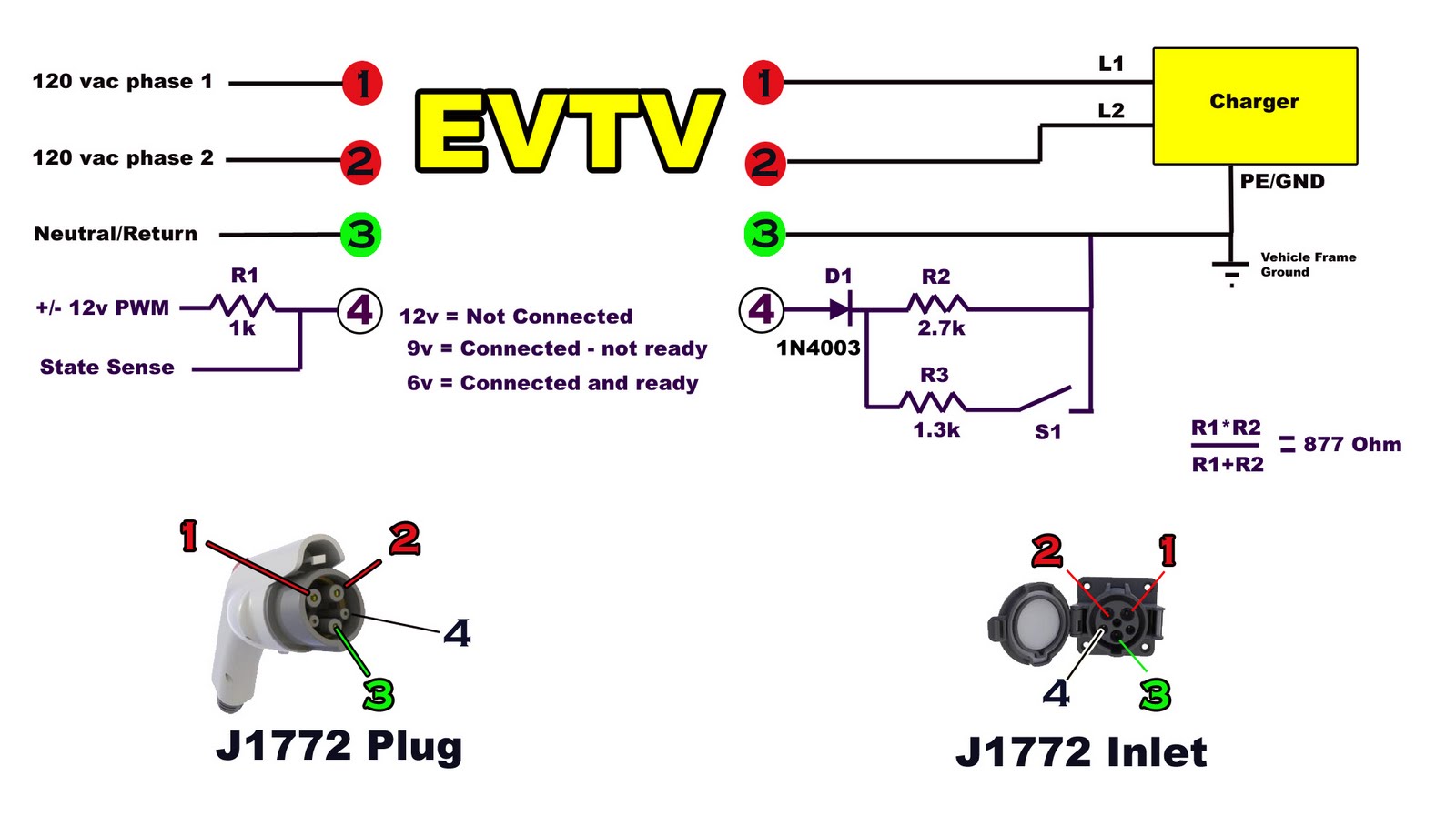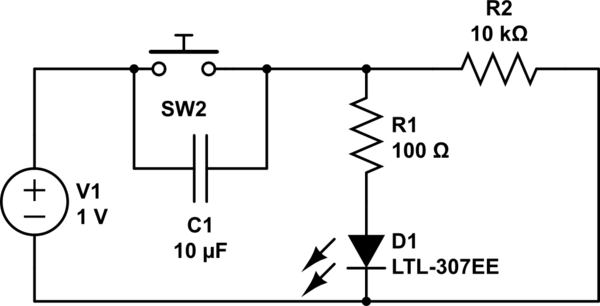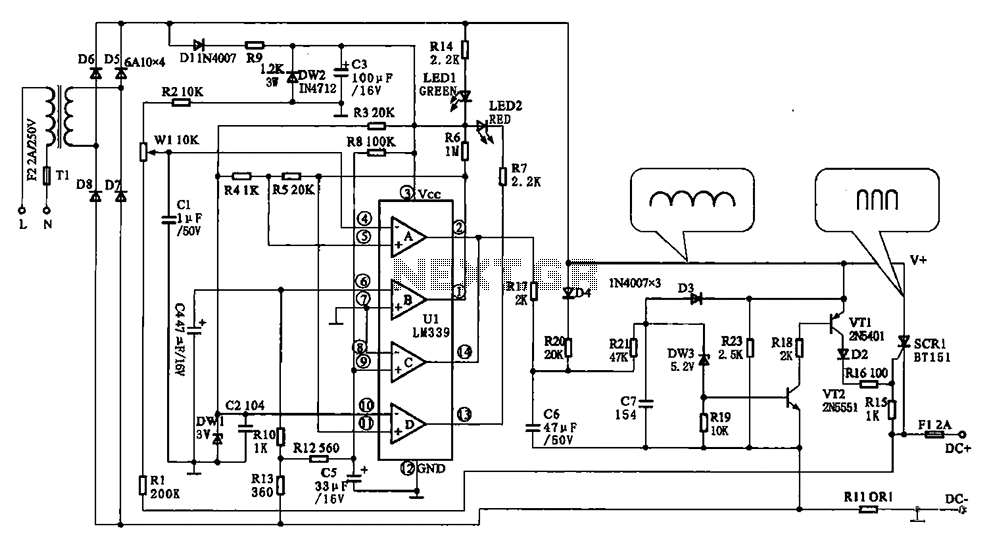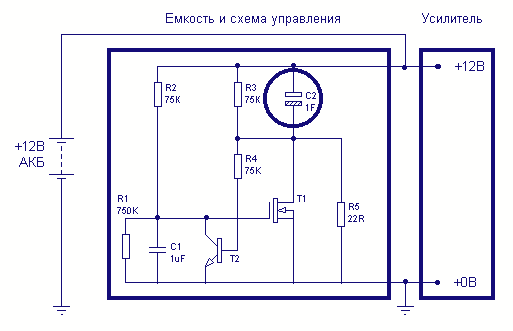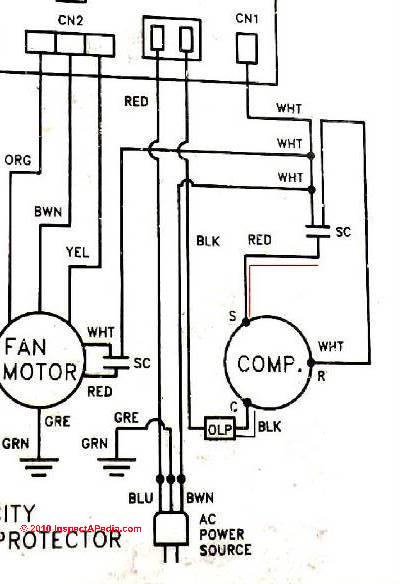
Capacitor charging and discharging

Large-value capacitors are necessary for this experiment to generate time constants slow enough to be monitored with a voltmeter and stopwatch. It is important to note that most large capacitors are of the "electrolytic" type, which are sensitive to polarity. One terminal of each capacitor is marked with a specific polarity sign. Typically, capacitors of the specified size have a negative (-) marking or a series of negative markings indicating the negative terminal. Very large capacitors may also have a positive (+) marking next to one terminal. Neglecting proper polarity can lead to capacitor failure, even with a source voltage as low as 6 volts. When electrolytic capacitors fail, they often explode, releasing caustic chemicals and producing unpleasant odors. To avoid this, construct the "charging" circuit and measure the voltage across the capacitor when the switch is closed, observing how it increases gradually over time rather than suddenly, as would occur with a resistor. The capacitor can be "reset" to a voltage of zero by shorting its terminals with a wire. The "time constant" (τ) of a resistor-capacitor circuit is calculated by multiplying the circuit resistance by the circuit capacitance. For a 1 kΩ resistor and a 1000 µF capacitor, the time constant should be 1 second. This indicates the time required for the capacitor voltage to increase to approximately 63.2% of its final value, which is the battery voltage. Plotting the voltage of a charging capacitor over time on graph paper can illustrate the development of the inverse exponential curve. To effectively visualize this circuit's action, it is necessary to slow down the charging process. A one-second time constant may not provide sufficient time for voltmeter readings. The time constant can be increased in two ways: by changing the total circuit resistance and/or altering the total circuit capacitance. Using identical resistors and capacitors, various series and parallel combinations can be experimented with to achieve the slowest charging action. It is understood that multiple resistors must be connected to form a higher total resistance, but the effects of series and parallel connections on capacitance should also be investigated. Ensure that the capacitor(s) are inserted in the correct direction, with the terminals labeled negative (-) positioned closest to the battery's negative terminal. The discharging circuit exhibits a similar change in capacitor voltage, with the voltage jumping to the full battery voltage when the switch closes and then gradually decreasing when the switch is opened. Further experimentation with different combinations of resistors and capacitors is encouraged, always ensuring the correct polarity of the capacitor.
The experiment described involves the use of large-value electrolytic capacitors, which are crucial for creating slow time constants in RC (resistor-capacitor) circuits. These capacitors are distinguished by their sensitivity to polarity, which must be respected to prevent catastrophic failure. The circuit's design allows for the measurement of voltage changes across the capacitor over time, demonstrating the exponential charging behavior characteristic of RC circuits.
The time constant (τ) is a key parameter in this experiment, defined as the product of resistance (R) and capacitance (C). For example, in a circuit with a 1 kΩ resistor and a 1000 µF capacitor, the time constant is calculated to be 1 second. This time constant indicates the duration required for the voltage across the capacitor to reach approximately 63.2% of its maximum value. The gradual rise in voltage can be monitored using a voltmeter, and the experiment can be enhanced by plotting the voltage against time to visualize the charging curve.
To achieve a longer time constant, one approach is to increase the resistance in the circuit. This can be accomplished by connecting multiple resistors in series, thereby increasing the total resistance. Alternatively, increasing the capacitance by connecting capacitors in parallel can also extend the time constant. The experiment encourages exploration of various configurations of resistors and capacitors to observe the effects on the charging rate.
Proper handling of the capacitors is essential, as incorrect polarity can lead to failure, often resulting in explosive outcomes. Therefore, care must be taken to ensure that the negative terminal of the capacitor is connected to the negative side of the battery. The discharging phase of the experiment mirrors the charging phase, with the voltage initially jumping to the battery voltage and then gradually decreasing upon opening the switch.
Overall, this experiment serves as an educational platform to explore the principles of RC circuits, the behavior of capacitors under different configurations, and the critical importance of adhering to polarity guidelines in the use of electrolytic capacitors.Large-value capacitors are required for this experiment to produce time constants slow enough to track with a voltmeter and stopwatch. Be warned that most large capacitors are of the "electrolytic" type, and they are polarity sensitive!
One terminal of each capacitor should be marked with a definite polarity sign. Usually capacitors of the size specified have a negative (-) marking or series of negative markings pointing toward the negative terminal. Very large capacitors are often polarity-labeled by a positive (+) marking next to one terminal. Failure to heed proper polarity will almost surely result in capacitor failure, even with a source voltage as low as 6 volts. When electrolytic capacitors fail, they typically explode, spewing caustic chemicals and emitting foul odors.
Please, try to avoid this! Build the "charging" circuit and measure voltage across the capacitor when the switch is closed. Notice how it increases slowly over time, rather than suddenly as would be the case with a resistor. You can "reset" the capacitor back to a voltage of zero by shorting across its terminals with a piece of wire. The "time constant" ( ) of a resistor capacitor circuit is calculated by taking the circuit resistance and multiplying it by the circuit capacitance.
For a 1 k © resistor and a 1000 µF capacitor, the time constant should be 1 second. This is the amount of time it takes for the capacitor voltage to increase approximately 63. 2% from its present value to its final value: the voltage of the battery. It is educational to plot the voltage of a charging capacitor over time on a sheet of graph paper, to see how the inverse exponential curve develops. In order to plot the action of this circuit, though, we must find a way of slowing it down. A one-second time constant doesn`t provide much time to take voltmeter readings! We can increase this circuit`s time constant two different ways: changing the total circuit resistance, and/or changing the total circuit capacitance.
Given a pair of identical resistors and a pair of identical capacitors, experiment with various series and parallel combinations to obtain the slowest charging action. You should already know by now how multiple resistors need to be connected to form a greater total resistance, but what about capacitors This circuit will demonstrate to you how capacitance changes with series and parallel capacitor connections.
Just be sure that you insert the capacitor(s) in the proper direction: with the ends labeled negative (-) electrically "closest" to the battery`s negative terminal! The discharging circuit provides the same kind of changing capacitor voltage, except this time the voltage jumps to full battery voltage when the switch closes and slowly falls when the switch is opened.
Experiment once again with different combinations of resistors and capacitors, making sure as always that the capacitor`s polarity is correct. 🔗 External reference
The experiment described involves the use of large-value electrolytic capacitors, which are crucial for creating slow time constants in RC (resistor-capacitor) circuits. These capacitors are distinguished by their sensitivity to polarity, which must be respected to prevent catastrophic failure. The circuit's design allows for the measurement of voltage changes across the capacitor over time, demonstrating the exponential charging behavior characteristic of RC circuits.
The time constant (τ) is a key parameter in this experiment, defined as the product of resistance (R) and capacitance (C). For example, in a circuit with a 1 kΩ resistor and a 1000 µF capacitor, the time constant is calculated to be 1 second. This time constant indicates the duration required for the voltage across the capacitor to reach approximately 63.2% of its maximum value. The gradual rise in voltage can be monitored using a voltmeter, and the experiment can be enhanced by plotting the voltage against time to visualize the charging curve.
To achieve a longer time constant, one approach is to increase the resistance in the circuit. This can be accomplished by connecting multiple resistors in series, thereby increasing the total resistance. Alternatively, increasing the capacitance by connecting capacitors in parallel can also extend the time constant. The experiment encourages exploration of various configurations of resistors and capacitors to observe the effects on the charging rate.
Proper handling of the capacitors is essential, as incorrect polarity can lead to failure, often resulting in explosive outcomes. Therefore, care must be taken to ensure that the negative terminal of the capacitor is connected to the negative side of the battery. The discharging phase of the experiment mirrors the charging phase, with the voltage initially jumping to the battery voltage and then gradually decreasing upon opening the switch.
Overall, this experiment serves as an educational platform to explore the principles of RC circuits, the behavior of capacitors under different configurations, and the critical importance of adhering to polarity guidelines in the use of electrolytic capacitors.Large-value capacitors are required for this experiment to produce time constants slow enough to track with a voltmeter and stopwatch. Be warned that most large capacitors are of the "electrolytic" type, and they are polarity sensitive!
One terminal of each capacitor should be marked with a definite polarity sign. Usually capacitors of the size specified have a negative (-) marking or series of negative markings pointing toward the negative terminal. Very large capacitors are often polarity-labeled by a positive (+) marking next to one terminal. Failure to heed proper polarity will almost surely result in capacitor failure, even with a source voltage as low as 6 volts. When electrolytic capacitors fail, they typically explode, spewing caustic chemicals and emitting foul odors.
Please, try to avoid this! Build the "charging" circuit and measure voltage across the capacitor when the switch is closed. Notice how it increases slowly over time, rather than suddenly as would be the case with a resistor. You can "reset" the capacitor back to a voltage of zero by shorting across its terminals with a piece of wire. The "time constant" ( ) of a resistor capacitor circuit is calculated by taking the circuit resistance and multiplying it by the circuit capacitance.
For a 1 k © resistor and a 1000 µF capacitor, the time constant should be 1 second. This is the amount of time it takes for the capacitor voltage to increase approximately 63. 2% from its present value to its final value: the voltage of the battery. It is educational to plot the voltage of a charging capacitor over time on a sheet of graph paper, to see how the inverse exponential curve develops. In order to plot the action of this circuit, though, we must find a way of slowing it down. A one-second time constant doesn`t provide much time to take voltmeter readings! We can increase this circuit`s time constant two different ways: changing the total circuit resistance, and/or changing the total circuit capacitance.
Given a pair of identical resistors and a pair of identical capacitors, experiment with various series and parallel combinations to obtain the slowest charging action. You should already know by now how multiple resistors need to be connected to form a greater total resistance, but what about capacitors This circuit will demonstrate to you how capacitance changes with series and parallel capacitor connections.
Just be sure that you insert the capacitor(s) in the proper direction: with the ends labeled negative (-) electrically "closest" to the battery`s negative terminal! The discharging circuit provides the same kind of changing capacitor voltage, except this time the voltage jumps to full battery voltage when the switch closes and slowly falls when the switch is opened.
Experiment once again with different combinations of resistors and capacitors, making sure as always that the capacitor`s polarity is correct. 🔗 External reference
